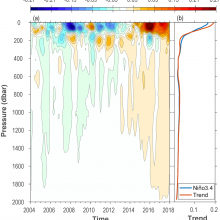State of the Climate in 2017
Johnson, G.C. (2018): Overview. In State of the Climate in 2017, Global Oceans. Bull. Am. Meteorol. Soc., 99(8), S69, doi: 10.1175/2018BAMSStateoftheClimate.1.
Feely, R.A., R. Wanninkhof, B.R. Carter, P. Landschützer, A.J. Sutton, and J.A. Triñanes (2018): Global ocean carbon cycle. In State of the Climate in 2017, Global Oceans. Bull. Am. Meteorol. Soc., 99(8), S96–S100.
Johnson, G.C., J.M. Lyman, T. Boyer, C.M. Domingues, J. Gilson, M. Ishii, R. Killick, D. Monselan, and S. Wijffels (2018): Ocean heat content. In State of the Climate in 2017, Global Oceans. Bull. Am. Meteorol. Soc., 99(8), S72–S77.
Johnson, G.C., J. Reagan, J.M. Lyman, T. Boyer, C. Schmid, and R. Locarnini (2018): Salinity. In State of the Climate in 2017, Global Oceans. Bull. Am. Meteorol. Soc., 99(8), S77–S81.
Overland, J., E. Hanna, I. Hanssen-Bauer, S.-J. Kim, J.E. Walsh, M. Wang, U.S. Bhatt, and R.L. Thoman (2018): Surface air temperature, in State of the Climate in 2017, The Arctic. Bull. Am. Meteorol. Soc., 99(8), S144–S146.
Timmermans, M.-L., C. Ladd, and K. Wood (2018): Sea Surface Temperature, in State of the Climate in 2017, The Arctic. Bull. Am. Meteorol. Soc., 99(8), S146–S147.
NOAA has led, for 28 years, a team of international scientists in issuing annual reports on the state of the climate focusing on the year just passed.

Ocean temperature anomalies. (a) Near-global integrals of ocean temperature anomalies relative to the record-length average seasonal cycle updated from Roemmich and Gilson (2009). (b) Linear trend of temperature anomalies (orange line), and trend with a Niño3.4 regression removed (blue line) following Johnson and Birnbaum (2017).


